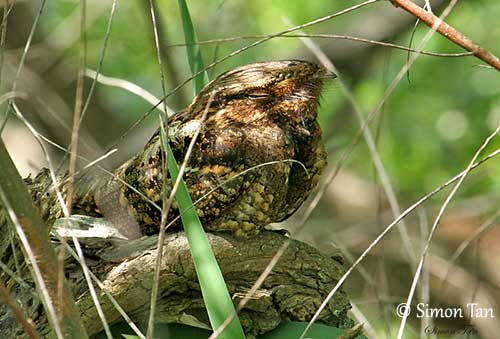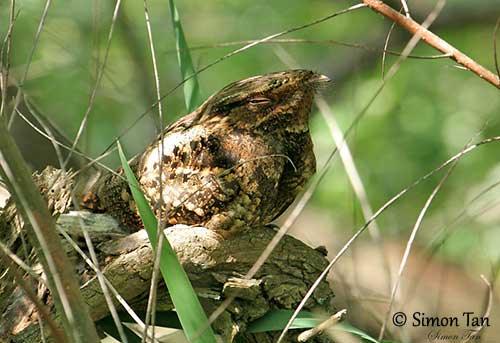
Fr: Engoulevent de Caroline
Ang: Chuck-will's-widow
All: Carolinanachtschwalbe
Esp: Chotacabras de la Carolina
Ita: Succiacapre della Carolina
Nd: Chuck Will's Widow
Sd: karolinan-a cm
Weight:ttskärra
Photographers:
Ken Havard
My Bird Gallery & Flickr gallery 1 & Flickr gallery 2
Simon Tan
PBase Bird galleries
Texte de Nicole Bouglouan
Sources:
HANDBOOK OF THE BIRDS OF THE WORLD Vol 5 by Josep del Hoyo-Andrew Elliott-Jordi Sargatal - Lynx Edicions - ISBN: 8487334253
NIGHTJARS - A Guide to Nightjars and Related Nightbirds – Nigel Cleere and Dave Nurney - Yale University Press - First Edition (August 11, 1998) - ISBN 10: 0300074573 / ISBN 13: 9780300074574
A GUIDE TO THE BIRDS OF MEXICO AND NORTHERN CENTRAL AMERICA by Steve N. G. Howell, Sophie Webb - Oxford University Press - ISBN: 0198540124
A GUIDE TO THE BIRDS OF COLOMBIA by Steven L. Hilty and William L. Brown - Princeton University Press – ISBN 069108372X
Animal Diversity Web (University of Michigan Museum of Zoology)
South Dakota Birds and Birding – (Terry L. Sohl)
What Bird-The ultimate Bird Guide (Mitchell Waite)
Wikipedia, the free encyclopaedia
Chuck-will's-widow
Antrostomus carolinensis
Caprimulgiformes Order – Caprimulgidae Family
INTRODUCTION:
The Chuck-will's-widow is the largest nightjar of North America. It breeds in SW USA from SE Canada, S to Texas and Florida. It winters in the Caribbean and through Central America to N South America.
During the breeding season, it frequents a variety of open woodlands, especially openings and edges, but also suburban areas with suitable sites. On migration and during winter, it is found in forested habitats, scrublands and agricultural fields.
It feeds on insects caught while flying low above the ground or over water. It forages mainly at dusk and dawn. Like other nightjars, it nests on the ground where the cryptic plumage makes the bird almost invisible.
The Chuck-will's-widow is threatened by degradation of the habitat, disturbance near the nest and use of pesticides. The population is declining and the species is currently listed as Near Threatened.

DESCRIPTION OF THE BIRD:
Biometrics:
Length: 27-34 cm
Wingspan: 62-65 cm
Weight: M: 94-137 g – F: 114-120 g
The Chuck-will's-widow has very cryptic plumage, as usual in nightjars. The cinnamon-brown, cream and black feathers help the bird to roost on tree branch and nest on the ground while being almost invisible.
The upperparts are brown with blackish-brown streaking and an indistinct tawny-buff nuchal collar. The scapulars are spotted blackish, whereas the wing-coverts are brown and heavily spotted buff and buffish-white.
The tail is long. When at rest, it projects beyond the wingtips. The male has white inner webs on the three outermost rectrices, whereas the tawny outer webs are speckled or barred blackish.
The underparts are brown with tawny and buff spots and speckles, but belly, flanks and undertail-coverts are barred buff and brown. We can see a narrow whitish band on the lower throat.
On the head, lores and ear-coverts are tawny and tinged rufous with dark brown speckles. Chin and throat are buff with narrow brown bars.
The bill is brownish-pink with dark tip. The eyes are dark brown. Legs and feet are brown.
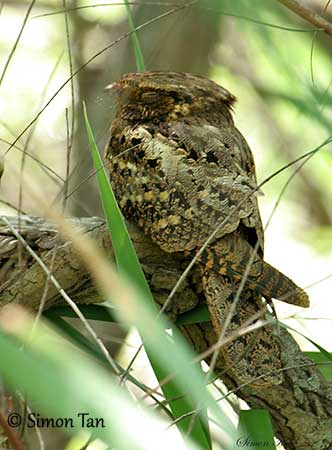
The female lacks the white outer tail feathers. She is slightly smaller than male.
The juvenile resembles female with buffier plumage overall.
RANGE:
The Chuck-will's-widow breeds in SW United States, from Florida to Long Island, New York and W to Kansas, Oklahoma and E Texas. Some populations breed in isolated sites in S Ontario, NW Indiana along Lake Michigan, and C and S Ohio.
It winters from S USA through Central America to N South America and from C Florida S through Bahamas to Greater Antilles, and E to Virgin Islands.
HABITAT:
The Chuck-will's-widow breeds in open woodlands such as deciduous, mixed pine/oak woodlands and wooded oak groves. It also frequents coniferous forests, agricultural areas and open country, and can be found in suburban areas with suitable habitats.
During migration and winter, it is found in a wide variety of forested habitats and scrublands, in second-growth woodland and thick riverside vegetation. The species is visible from sea-level to 2,600 metres of elevation.
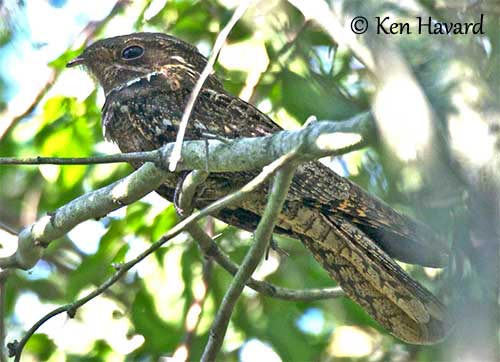
CALLS AND SONGS: SOUNDS BY XENO-CANTO
The Chuck-will's-widow gets its name from its song, and the species is usually detected thanks to the vocalizations.
Both sexes call in flight, giving a variety of clucking or growling calls and deep “quok” notes. The birds give throaty hisses during threat and defence displays.
The male’s song is described as a loud “chuck weeo weeo” with the first syllable percussive while the others are rich, mid-range whistles. This song is also rendered as “chuck-will-wid-ow” and gives the bird its name.
The male sings from a perch up to 16-30 times per minute. It sings during the courtship period and continues during the nesting season. Then, it sings again prior to fall migration.
BEHAVIOUR IN THE WILD:
The Chuck-will's-widow feeds on large insects, especially large night-flying insects such as beetles and moths, and mainly Geometridae moths. However, it may occasionally take small birds.
The bird forages at dusk and dawn, flying out from a perch in tree or from the ground, to catch some flying insects. The prey is caught within its wide, gaping mouth, and the rictal bristles help to attract the insects into the mouth.
In the same way, it may sometimes swallow small birds, especially Warblers and even bats.
The Chuck-will's-widow is often observed collecting rocks on roads, probably to aid digestion.
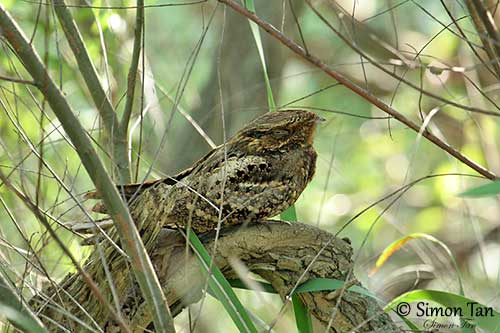
During the breeding season, the male defends the mating territory by chasing rival males away.
The Chuck-will's-widow sings to proclaim the territory and to attract a female. It also performs courtship displays during daytime, during which the tail is spread, the plumage is puffed up and the wings drooped. The male hops around the ground with jerky actions near the female and sings. When finished, it comes alongside the female.
Males and females may join again to breed together from year to year at the same site.
The Chuck-will's-widow migrates after breeding to spend the winter in Central and N South America.
The males usually migrate before the females. The adults tend to winter in the Greater Antilles, whereas the immatures reach Central and South America.
The flight is buoyant. They usually migrate in groups.
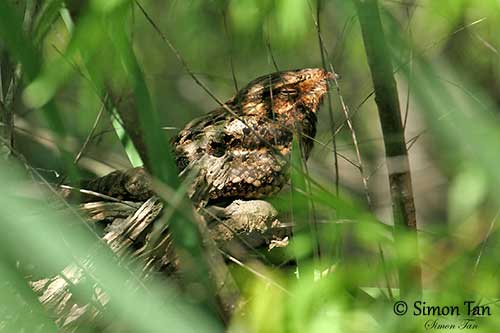
REPRODUCTION OF THIS SPECIES:
Most birds arrive on the breeding grounds in March, and breeding takes place from mid-April to July. Pair formation occurs within ten days of females arriving on the site.
The nest-site is on the ground and in fairly open area, often in shady understorey of forest. No nest built. The eggs are laid in a simple scrap on the ground, on leaves or pine needles.
The female lays two creamy-white eggs with brown and grey markings. The incubation lasts 20-21 days, mainly by the female because the male lacks the brood patch. She broods and shelters the young during the day. The chicks are fed on regurgitated insects by both parents.
If disturbed, the adults may move the eggs some distance away. The female gives distraction display if the nest-site is threatened. A replacement clutch is laid if the first brood is lost.
The male may help the female but it spends less time at nest as it defends the territory.
The young are able to fly about 17 days after hatching, and are completely feathered. They depend on parents for another two weeks.
PROTECTION / THREATS / STATUS:
The Chuck-will's-widow is threatened first by degradation of the habitat due to urbanization and forest loss. It is also affected by the use of pesticides, as it feeds mainly on insects.
The global population is estimated to number 5,700,000 mature individuals and it has been suspected to be declining by about 2,3% per year between 1966 and 2015.
The Chuck-will's-widow is currently listed as Near Threatened.
